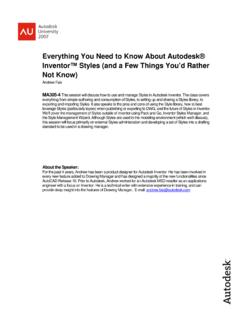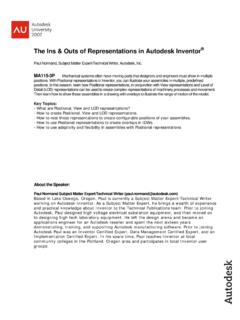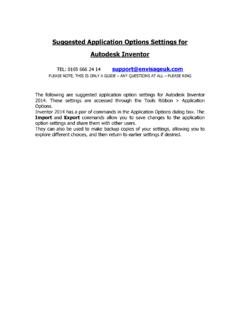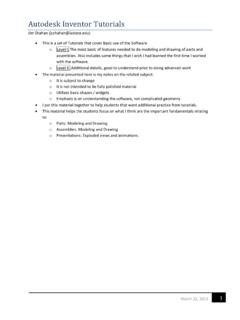Transcription of Derived Parts in Autodesk Inventor® - widom …
1 Walt Disney World Swan and Dolphin ResortOrlando, Florida11/28/2005 - 5:00 pm - 6:30 pm Room:Mockingbird 1/2 [Lab] (Swan) Derived Parts in Autodesk Inventor Derived Parts are a powerful but easy-to-use too in Inventor. They come in two basic flavors: you can derive a part from another one, or you can derive a part from an assembly. Using Derived Parts , you can easily create machining models and drawings from an as-cast model, and you can create a mold from the same model. The mold cavity can be scaled to allow for shrinkage.
2 Opposite-hand versions can also be created from the base part and from any subsequent Derived Parts . If the basic part is changed then everything the Speaker:Bill Fane - BCIT / CADALYSTC hristiaan Bowen (Assistant); Brian Verboort (Assistant)andAn AutoCAD software user since 1986, Bill was a product engineer and manager for Weiser Lock in Vancouver, Canada for 27 years. Bill has taught AutoCAD and mechanical design at the British Columbia Institute of Technology since 1996 and teaches Autodesk Inventor at the Institute s Training Center.
3 He has lectured on a wide range of subjects at Autodesk University since 1995. An active member of the Vancouver AutoCAD Users Society, he has written "The Learning Curve" column for CADalyst magazine since 1986, and writes about Autodesk Mechanical Desktop and Autodesk Inventor for Autodesk 's Point A Toplines. He also writes for Inside AutoCAD Journal and Design Product News. MA15-1L Derived Parts in Autodesk Inventor 2/9 NOTE This lab is intended for INTERMEDIATE users.
4 I assume you are familiar with the basic operations within Inventor, including the production of Parts , assemblies, and 2D working drawings. The Deriving Most of the time, the production of a part model in Inventor is a serial process. You start with a single sketch, dimension and constrain it, then turn it into a solid. The process is repeated, adding and subtracting features, until the part is finished. The Browser shows this sequence. Yes, under the right conditions you can drag individual features up and down the browser to change their relative position within the history tree, but the final result is still a sequential process.
5 This sequential process serves us well enough most of the time, but there are two main situations in which it can be a problem: 1. A primary part such as a forging receives secondary machining operations. You need both a forging drawing and a machining drawing. 2. You need a part that is actually a negative image of another; you have modeled a complex part and now you need the dies or molds for it. The Party Of The First Let s start with the first case, where you need a primary drawing and a machining drawing. The brute force method would be to model the primary part and then the machining features, and then create the 2D drawing.
6 Now, when you want the primary part drawing you suppress the machining details and plot the drawing. To get the machining drawing, unsuppress the machining details in the part, and then suppress all of the primary part dimensions in the hey, this could get out of hand! It gets worse. What if the same primary part branches into two or more different machined configurations, or what if it goes through several levels of secondary operations? What if you want the primary part and the machining details in one 2D drawing?
7 Okay, now let s look at the second case. Having built the part, how do you create the mold or die for it? The brute force method would be to build the part from scratch again, but this time you start with a solid block and then reverse all the Boolean operations; subtract instead of add and vise-versa. Meanwhile, you have to allow for shrinkage as the part solidifies and cools, and by the way we also need a left-hand version of the This Is So Fortunately there is a better way of solving both situations. Actually, it is doubly fortunate.
8 Not only do we get a better way of doing things, but we also get a good tutorial topic. The better way is called Derived Parts . Basically, this means that we can create a part or an assembly and then derive other Parts from it. Parametric relationships are still maintained, so that if the base part changes, or if a part within an assembly changes, then the Derived part or Parts will follow. The End Is The first case, where we derive a machined part from a primary one, is a little simpler so we will start with it.
9 MA15-1L Derived Parts in Autodesk Inventor 3/9 1. Activate the C:\datasets\MA15-1L\ Derived project. 2. Open the file <path>Rod This step is not essential to the process, but it will help you to see what we are doing. 3. Start a new part from the English \ Standard(in).ipt template 4. Click Return to cancel the sketch.
10 5. Click Derived Component down near the bottom of the Part Features panel. 6. In the file dialog, select and open the Rod file 7. The Derived Part dialog box appears. If you click on a grey round \ button then it will turn into a yellow + one. For our purposes at this time the only yellow + button should be the Solid Body one. We will come back later to investigate what the other ones do. 8. Click OK. The part is inserted into the new file. At first glance this file would appear to be exactly identical to the Rod file opened earlier, but a closer examination reveals that the browser is different.







